HLTH 1047 Assignment 1: Asthma and First People Health in Australia
VerifiedAdded on 2023/06/10
|7
|2784
|299
Essay
AI Summary
This essay examines the chronic respiratory condition of asthma, focusing on its disproportionate impact on Australian Aboriginal and Torres Strait Islander peoples (AATIP). It highlights the increased prevalence of asthma within this population, citing contributing factors such as poor asthma management, socioeconomic disparities, and smoking rates. The essay discusses healthcare strategies, including the importance of a well-resourced and trained healthcare workforce involving various professionals like respiratory educators, nurses, and pharmacists, with a focus on primary health care. It also explores medication usage among AATIP, noting the adoption of controller and quick-relief medications, and the use of asthma inhalers, nebulizers, and corticosteroids. The essay concludes by emphasizing the need for improved asthma management and interventions tailored to the unique challenges faced by the AATIP, advocating for holistic and multidisciplinary approaches to healthcare delivery.
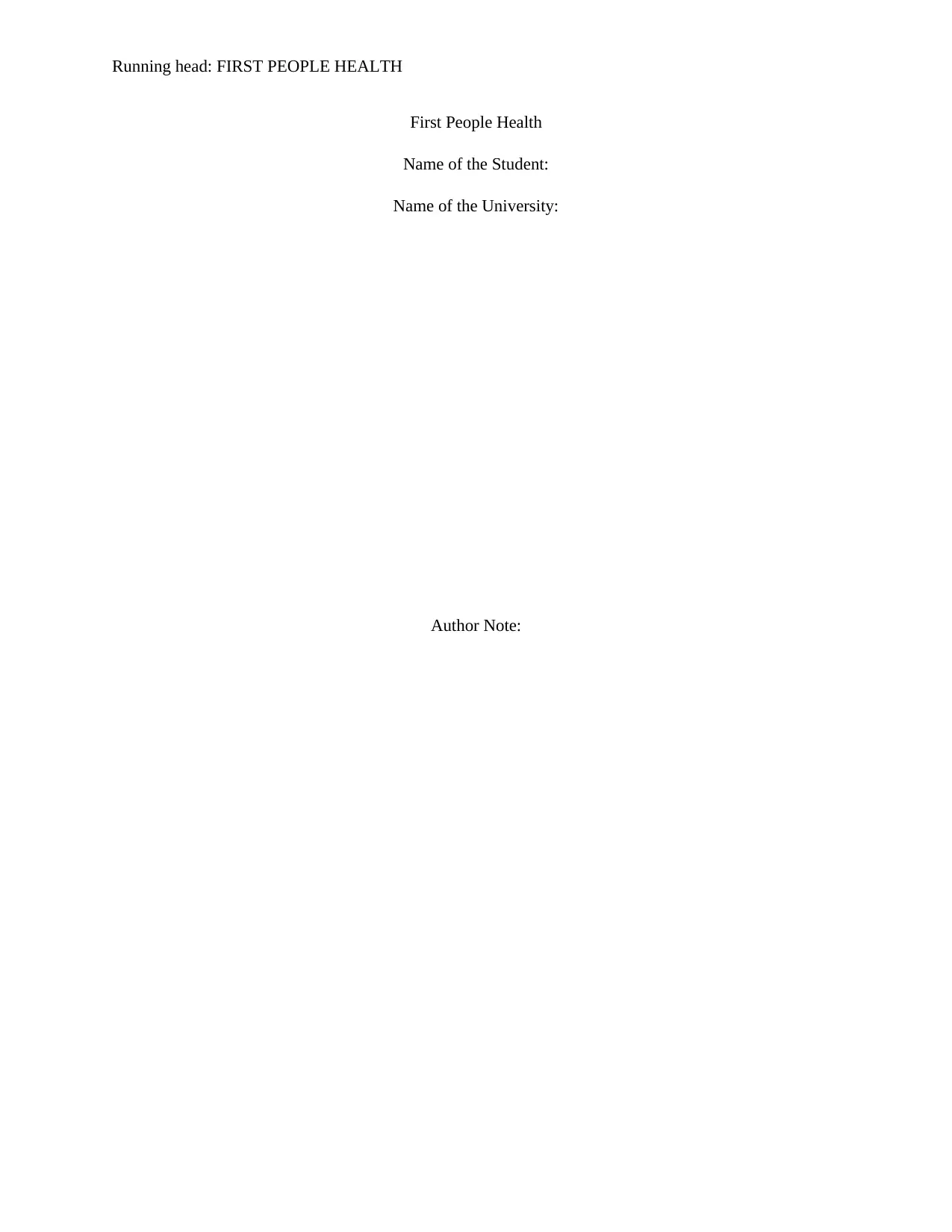
Running head: FIRST PEOPLE HEALTH
First People Health
Name of the Student:
Name of the University:
Author Note:
First People Health
Name of the Student:
Name of the University:
Author Note:
Paraphrase This Document
Need a fresh take? Get an instant paraphrase of this document with our AI Paraphraser
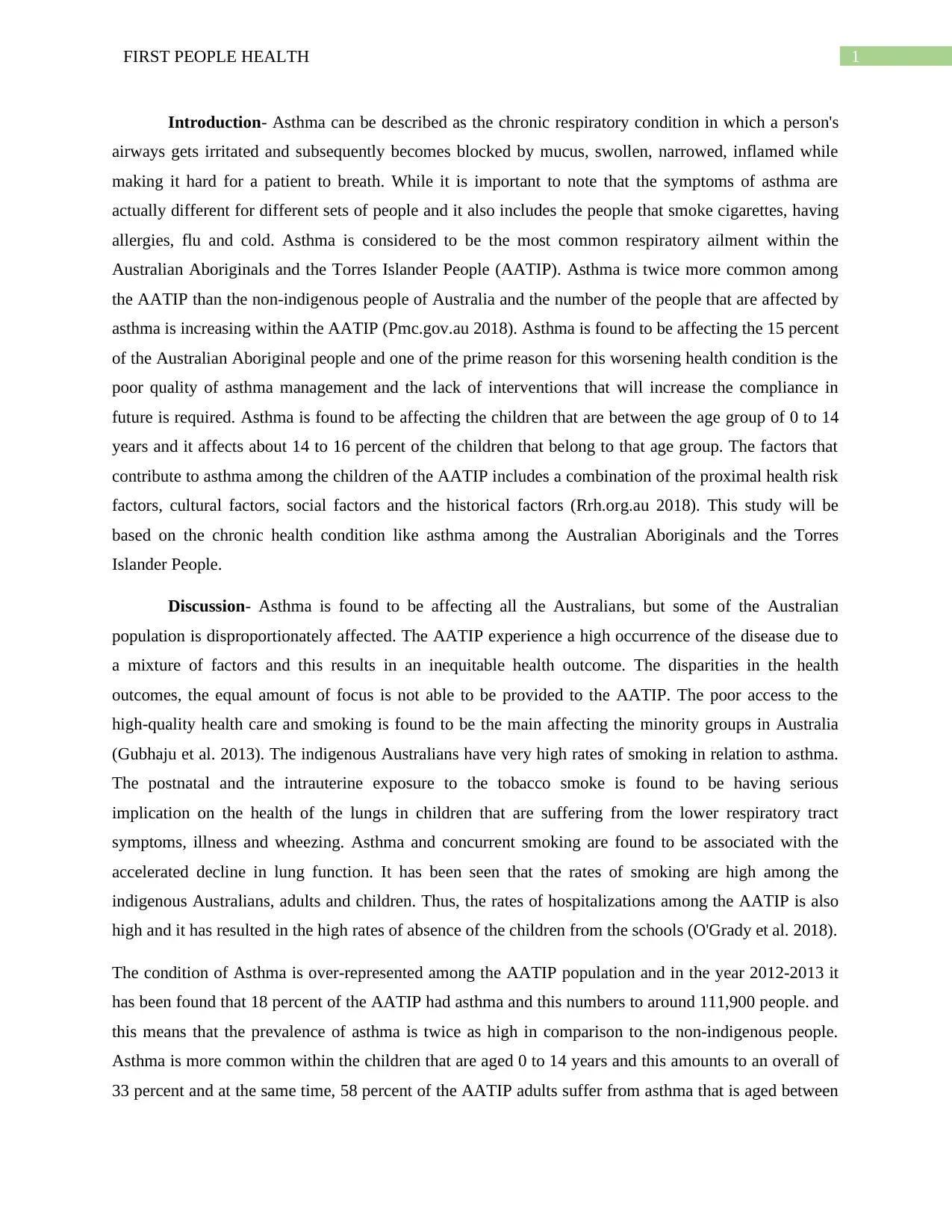
1FIRST PEOPLE HEALTH
Introduction- Asthma can be described as the chronic respiratory condition in which a person's
airways gets irritated and subsequently becomes blocked by mucus, swollen, narrowed, inflamed while
making it hard for a patient to breath. While it is important to note that the symptoms of asthma are
actually different for different sets of people and it also includes the people that smoke cigarettes, having
allergies, flu and cold. Asthma is considered to be the most common respiratory ailment within the
Australian Aboriginals and the Torres Islander People (AATIP). Asthma is twice more common among
the AATIP than the non-indigenous people of Australia and the number of the people that are affected by
asthma is increasing within the AATIP (Pmc.gov.au 2018). Asthma is found to be affecting the 15 percent
of the Australian Aboriginal people and one of the prime reason for this worsening health condition is the
poor quality of asthma management and the lack of interventions that will increase the compliance in
future is required. Asthma is found to be affecting the children that are between the age group of 0 to 14
years and it affects about 14 to 16 percent of the children that belong to that age group. The factors that
contribute to asthma among the children of the AATIP includes a combination of the proximal health risk
factors, cultural factors, social factors and the historical factors (Rrh.org.au 2018). This study will be
based on the chronic health condition like asthma among the Australian Aboriginals and the Torres
Islander People.
Discussion- Asthma is found to be affecting all the Australians, but some of the Australian
population is disproportionately affected. The AATIP experience a high occurrence of the disease due to
a mixture of factors and this results in an inequitable health outcome. The disparities in the health
outcomes, the equal amount of focus is not able to be provided to the AATIP. The poor access to the
high-quality health care and smoking is found to be the main affecting the minority groups in Australia
(Gubhaju et al. 2013). The indigenous Australians have very high rates of smoking in relation to asthma.
The postnatal and the intrauterine exposure to the tobacco smoke is found to be having serious
implication on the health of the lungs in children that are suffering from the lower respiratory tract
symptoms, illness and wheezing. Asthma and concurrent smoking are found to be associated with the
accelerated decline in lung function. It has been seen that the rates of smoking are high among the
indigenous Australians, adults and children. Thus, the rates of hospitalizations among the AATIP is also
high and it has resulted in the high rates of absence of the children from the schools (O'Grady et al. 2018).
The condition of Asthma is over-represented among the AATIP population and in the year 2012-2013 it
has been found that 18 percent of the AATIP had asthma and this numbers to around 111,900 people. and
this means that the prevalence of asthma is twice as high in comparison to the non-indigenous people.
Asthma is more common within the children that are aged 0 to 14 years and this amounts to an overall of
33 percent and at the same time, 58 percent of the AATIP adults suffer from asthma that is aged between
Introduction- Asthma can be described as the chronic respiratory condition in which a person's
airways gets irritated and subsequently becomes blocked by mucus, swollen, narrowed, inflamed while
making it hard for a patient to breath. While it is important to note that the symptoms of asthma are
actually different for different sets of people and it also includes the people that smoke cigarettes, having
allergies, flu and cold. Asthma is considered to be the most common respiratory ailment within the
Australian Aboriginals and the Torres Islander People (AATIP). Asthma is twice more common among
the AATIP than the non-indigenous people of Australia and the number of the people that are affected by
asthma is increasing within the AATIP (Pmc.gov.au 2018). Asthma is found to be affecting the 15 percent
of the Australian Aboriginal people and one of the prime reason for this worsening health condition is the
poor quality of asthma management and the lack of interventions that will increase the compliance in
future is required. Asthma is found to be affecting the children that are between the age group of 0 to 14
years and it affects about 14 to 16 percent of the children that belong to that age group. The factors that
contribute to asthma among the children of the AATIP includes a combination of the proximal health risk
factors, cultural factors, social factors and the historical factors (Rrh.org.au 2018). This study will be
based on the chronic health condition like asthma among the Australian Aboriginals and the Torres
Islander People.
Discussion- Asthma is found to be affecting all the Australians, but some of the Australian
population is disproportionately affected. The AATIP experience a high occurrence of the disease due to
a mixture of factors and this results in an inequitable health outcome. The disparities in the health
outcomes, the equal amount of focus is not able to be provided to the AATIP. The poor access to the
high-quality health care and smoking is found to be the main affecting the minority groups in Australia
(Gubhaju et al. 2013). The indigenous Australians have very high rates of smoking in relation to asthma.
The postnatal and the intrauterine exposure to the tobacco smoke is found to be having serious
implication on the health of the lungs in children that are suffering from the lower respiratory tract
symptoms, illness and wheezing. Asthma and concurrent smoking are found to be associated with the
accelerated decline in lung function. It has been seen that the rates of smoking are high among the
indigenous Australians, adults and children. Thus, the rates of hospitalizations among the AATIP is also
high and it has resulted in the high rates of absence of the children from the schools (O'Grady et al. 2018).
The condition of Asthma is over-represented among the AATIP population and in the year 2012-2013 it
has been found that 18 percent of the AATIP had asthma and this numbers to around 111,900 people. and
this means that the prevalence of asthma is twice as high in comparison to the non-indigenous people.
Asthma is more common within the children that are aged 0 to 14 years and this amounts to an overall of
33 percent and at the same time, 58 percent of the AATIP adults suffer from asthma that is aged between
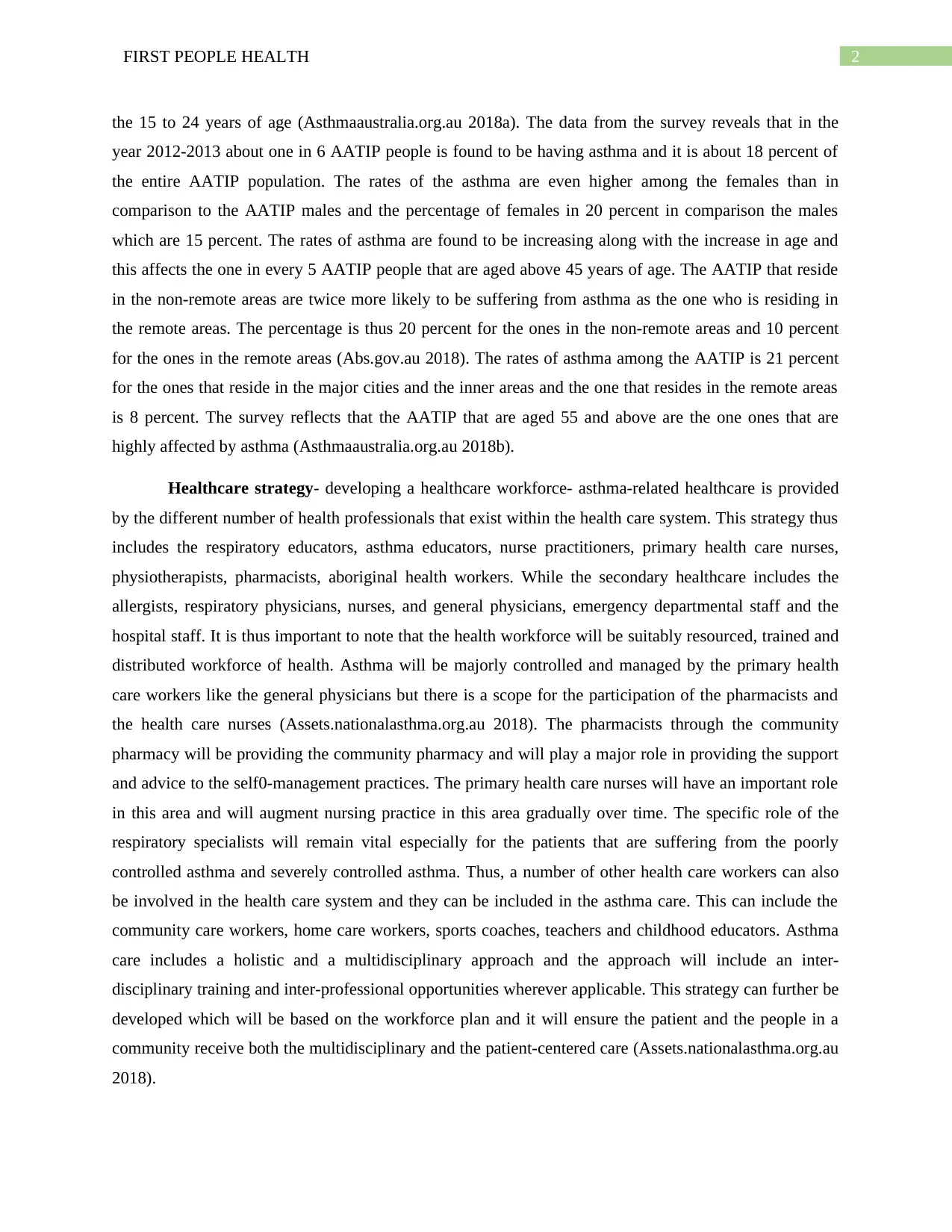
2FIRST PEOPLE HEALTH
the 15 to 24 years of age (Asthmaaustralia.org.au 2018a). The data from the survey reveals that in the
year 2012-2013 about one in 6 AATIP people is found to be having asthma and it is about 18 percent of
the entire AATIP population. The rates of the asthma are even higher among the females than in
comparison to the AATIP males and the percentage of females in 20 percent in comparison the males
which are 15 percent. The rates of asthma are found to be increasing along with the increase in age and
this affects the one in every 5 AATIP people that are aged above 45 years of age. The AATIP that reside
in the non-remote areas are twice more likely to be suffering from asthma as the one who is residing in
the remote areas. The percentage is thus 20 percent for the ones in the non-remote areas and 10 percent
for the ones in the remote areas (Abs.gov.au 2018). The rates of asthma among the AATIP is 21 percent
for the ones that reside in the major cities and the inner areas and the one that resides in the remote areas
is 8 percent. The survey reflects that the AATIP that are aged 55 and above are the one ones that are
highly affected by asthma (Asthmaaustralia.org.au 2018b).
Healthcare strategy- developing a healthcare workforce- asthma-related healthcare is provided
by the different number of health professionals that exist within the health care system. This strategy thus
includes the respiratory educators, asthma educators, nurse practitioners, primary health care nurses,
physiotherapists, pharmacists, aboriginal health workers. While the secondary healthcare includes the
allergists, respiratory physicians, nurses, and general physicians, emergency departmental staff and the
hospital staff. It is thus important to note that the health workforce will be suitably resourced, trained and
distributed workforce of health. Asthma will be majorly controlled and managed by the primary health
care workers like the general physicians but there is a scope for the participation of the pharmacists and
the health care nurses (Assets.nationalasthma.org.au 2018). The pharmacists through the community
pharmacy will be providing the community pharmacy and will play a major role in providing the support
and advice to the self0-management practices. The primary health care nurses will have an important role
in this area and will augment nursing practice in this area gradually over time. The specific role of the
respiratory specialists will remain vital especially for the patients that are suffering from the poorly
controlled asthma and severely controlled asthma. Thus, a number of other health care workers can also
be involved in the health care system and they can be included in the asthma care. This can include the
community care workers, home care workers, sports coaches, teachers and childhood educators. Asthma
care includes a holistic and a multidisciplinary approach and the approach will include an inter-
disciplinary training and inter-professional opportunities wherever applicable. This strategy can further be
developed which will be based on the workforce plan and it will ensure the patient and the people in a
community receive both the multidisciplinary and the patient-centered care (Assets.nationalasthma.org.au
2018).
the 15 to 24 years of age (Asthmaaustralia.org.au 2018a). The data from the survey reveals that in the
year 2012-2013 about one in 6 AATIP people is found to be having asthma and it is about 18 percent of
the entire AATIP population. The rates of the asthma are even higher among the females than in
comparison to the AATIP males and the percentage of females in 20 percent in comparison the males
which are 15 percent. The rates of asthma are found to be increasing along with the increase in age and
this affects the one in every 5 AATIP people that are aged above 45 years of age. The AATIP that reside
in the non-remote areas are twice more likely to be suffering from asthma as the one who is residing in
the remote areas. The percentage is thus 20 percent for the ones in the non-remote areas and 10 percent
for the ones in the remote areas (Abs.gov.au 2018). The rates of asthma among the AATIP is 21 percent
for the ones that reside in the major cities and the inner areas and the one that resides in the remote areas
is 8 percent. The survey reflects that the AATIP that are aged 55 and above are the one ones that are
highly affected by asthma (Asthmaaustralia.org.au 2018b).
Healthcare strategy- developing a healthcare workforce- asthma-related healthcare is provided
by the different number of health professionals that exist within the health care system. This strategy thus
includes the respiratory educators, asthma educators, nurse practitioners, primary health care nurses,
physiotherapists, pharmacists, aboriginal health workers. While the secondary healthcare includes the
allergists, respiratory physicians, nurses, and general physicians, emergency departmental staff and the
hospital staff. It is thus important to note that the health workforce will be suitably resourced, trained and
distributed workforce of health. Asthma will be majorly controlled and managed by the primary health
care workers like the general physicians but there is a scope for the participation of the pharmacists and
the health care nurses (Assets.nationalasthma.org.au 2018). The pharmacists through the community
pharmacy will be providing the community pharmacy and will play a major role in providing the support
and advice to the self0-management practices. The primary health care nurses will have an important role
in this area and will augment nursing practice in this area gradually over time. The specific role of the
respiratory specialists will remain vital especially for the patients that are suffering from the poorly
controlled asthma and severely controlled asthma. Thus, a number of other health care workers can also
be involved in the health care system and they can be included in the asthma care. This can include the
community care workers, home care workers, sports coaches, teachers and childhood educators. Asthma
care includes a holistic and a multidisciplinary approach and the approach will include an inter-
disciplinary training and inter-professional opportunities wherever applicable. This strategy can further be
developed which will be based on the workforce plan and it will ensure the patient and the people in a
community receive both the multidisciplinary and the patient-centered care (Assets.nationalasthma.org.au
2018).
⊘ This is a preview!⊘
Do you want full access?
Subscribe today to unlock all pages.

Trusted by 1+ million students worldwide
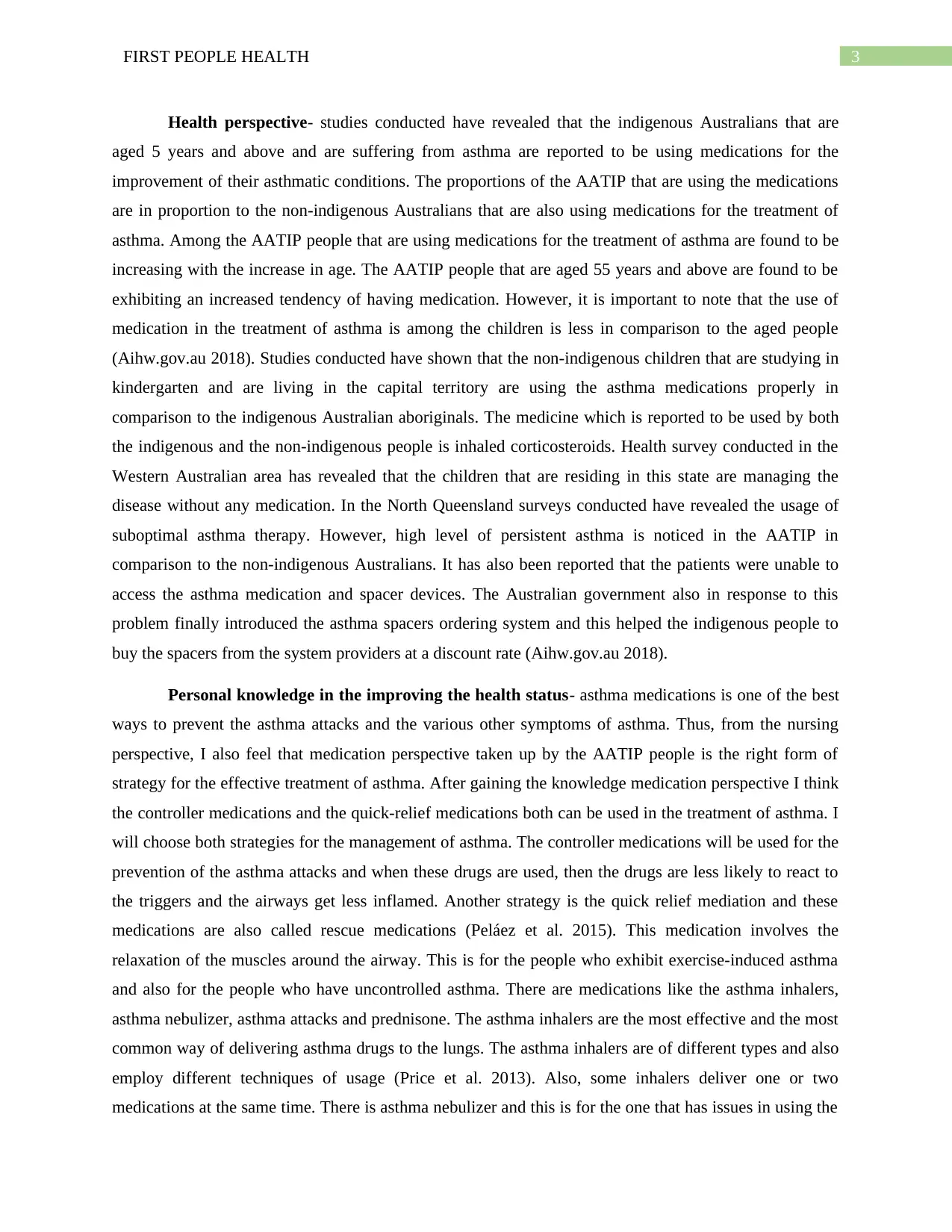
3FIRST PEOPLE HEALTH
Health perspective- studies conducted have revealed that the indigenous Australians that are
aged 5 years and above and are suffering from asthma are reported to be using medications for the
improvement of their asthmatic conditions. The proportions of the AATIP that are using the medications
are in proportion to the non-indigenous Australians that are also using medications for the treatment of
asthma. Among the AATIP people that are using medications for the treatment of asthma are found to be
increasing with the increase in age. The AATIP people that are aged 55 years and above are found to be
exhibiting an increased tendency of having medication. However, it is important to note that the use of
medication in the treatment of asthma is among the children is less in comparison to the aged people
(Aihw.gov.au 2018). Studies conducted have shown that the non-indigenous children that are studying in
kindergarten and are living in the capital territory are using the asthma medications properly in
comparison to the indigenous Australian aboriginals. The medicine which is reported to be used by both
the indigenous and the non-indigenous people is inhaled corticosteroids. Health survey conducted in the
Western Australian area has revealed that the children that are residing in this state are managing the
disease without any medication. In the North Queensland surveys conducted have revealed the usage of
suboptimal asthma therapy. However, high level of persistent asthma is noticed in the AATIP in
comparison to the non-indigenous Australians. It has also been reported that the patients were unable to
access the asthma medication and spacer devices. The Australian government also in response to this
problem finally introduced the asthma spacers ordering system and this helped the indigenous people to
buy the spacers from the system providers at a discount rate (Aihw.gov.au 2018).
Personal knowledge in the improving the health status- asthma medications is one of the best
ways to prevent the asthma attacks and the various other symptoms of asthma. Thus, from the nursing
perspective, I also feel that medication perspective taken up by the AATIP people is the right form of
strategy for the effective treatment of asthma. After gaining the knowledge medication perspective I think
the controller medications and the quick-relief medications both can be used in the treatment of asthma. I
will choose both strategies for the management of asthma. The controller medications will be used for the
prevention of the asthma attacks and when these drugs are used, then the drugs are less likely to react to
the triggers and the airways get less inflamed. Another strategy is the quick relief mediation and these
medications are also called rescue medications (Peláez et al. 2015). This medication involves the
relaxation of the muscles around the airway. This is for the people who exhibit exercise-induced asthma
and also for the people who have uncontrolled asthma. There are medications like the asthma inhalers,
asthma nebulizer, asthma attacks and prednisone. The asthma inhalers are the most effective and the most
common way of delivering asthma drugs to the lungs. The asthma inhalers are of different types and also
employ different techniques of usage (Price et al. 2013). Also, some inhalers deliver one or two
medications at the same time. There is asthma nebulizer and this is for the one that has issues in using the
Health perspective- studies conducted have revealed that the indigenous Australians that are
aged 5 years and above and are suffering from asthma are reported to be using medications for the
improvement of their asthmatic conditions. The proportions of the AATIP that are using the medications
are in proportion to the non-indigenous Australians that are also using medications for the treatment of
asthma. Among the AATIP people that are using medications for the treatment of asthma are found to be
increasing with the increase in age. The AATIP people that are aged 55 years and above are found to be
exhibiting an increased tendency of having medication. However, it is important to note that the use of
medication in the treatment of asthma is among the children is less in comparison to the aged people
(Aihw.gov.au 2018). Studies conducted have shown that the non-indigenous children that are studying in
kindergarten and are living in the capital territory are using the asthma medications properly in
comparison to the indigenous Australian aboriginals. The medicine which is reported to be used by both
the indigenous and the non-indigenous people is inhaled corticosteroids. Health survey conducted in the
Western Australian area has revealed that the children that are residing in this state are managing the
disease without any medication. In the North Queensland surveys conducted have revealed the usage of
suboptimal asthma therapy. However, high level of persistent asthma is noticed in the AATIP in
comparison to the non-indigenous Australians. It has also been reported that the patients were unable to
access the asthma medication and spacer devices. The Australian government also in response to this
problem finally introduced the asthma spacers ordering system and this helped the indigenous people to
buy the spacers from the system providers at a discount rate (Aihw.gov.au 2018).
Personal knowledge in the improving the health status- asthma medications is one of the best
ways to prevent the asthma attacks and the various other symptoms of asthma. Thus, from the nursing
perspective, I also feel that medication perspective taken up by the AATIP people is the right form of
strategy for the effective treatment of asthma. After gaining the knowledge medication perspective I think
the controller medications and the quick-relief medications both can be used in the treatment of asthma. I
will choose both strategies for the management of asthma. The controller medications will be used for the
prevention of the asthma attacks and when these drugs are used, then the drugs are less likely to react to
the triggers and the airways get less inflamed. Another strategy is the quick relief mediation and these
medications are also called rescue medications (Peláez et al. 2015). This medication involves the
relaxation of the muscles around the airway. This is for the people who exhibit exercise-induced asthma
and also for the people who have uncontrolled asthma. There are medications like the asthma inhalers,
asthma nebulizer, asthma attacks and prednisone. The asthma inhalers are the most effective and the most
common way of delivering asthma drugs to the lungs. The asthma inhalers are of different types and also
employ different techniques of usage (Price et al. 2013). Also, some inhalers deliver one or two
medications at the same time. There is asthma nebulizer and this is for the one that has issues in using the
Paraphrase This Document
Need a fresh take? Get an instant paraphrase of this document with our AI Paraphraser
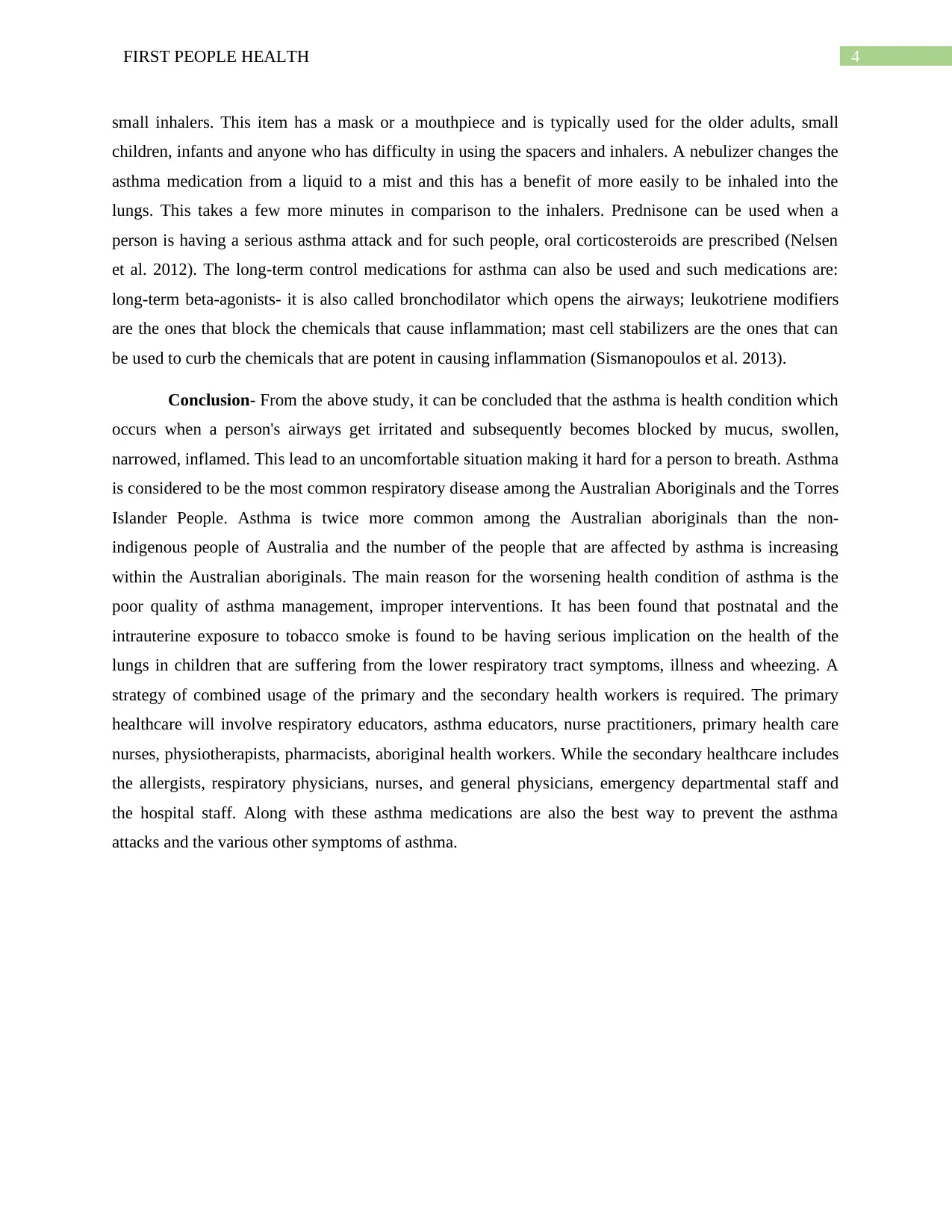
4FIRST PEOPLE HEALTH
small inhalers. This item has a mask or a mouthpiece and is typically used for the older adults, small
children, infants and anyone who has difficulty in using the spacers and inhalers. A nebulizer changes the
asthma medication from a liquid to a mist and this has a benefit of more easily to be inhaled into the
lungs. This takes a few more minutes in comparison to the inhalers. Prednisone can be used when a
person is having a serious asthma attack and for such people, oral corticosteroids are prescribed (Nelsen
et al. 2012). The long-term control medications for asthma can also be used and such medications are:
long-term beta-agonists- it is also called bronchodilator which opens the airways; leukotriene modifiers
are the ones that block the chemicals that cause inflammation; mast cell stabilizers are the ones that can
be used to curb the chemicals that are potent in causing inflammation (Sismanopoulos et al. 2013).
Conclusion- From the above study, it can be concluded that the asthma is health condition which
occurs when a person's airways get irritated and subsequently becomes blocked by mucus, swollen,
narrowed, inflamed. This lead to an uncomfortable situation making it hard for a person to breath. Asthma
is considered to be the most common respiratory disease among the Australian Aboriginals and the Torres
Islander People. Asthma is twice more common among the Australian aboriginals than the non-
indigenous people of Australia and the number of the people that are affected by asthma is increasing
within the Australian aboriginals. The main reason for the worsening health condition of asthma is the
poor quality of asthma management, improper interventions. It has been found that postnatal and the
intrauterine exposure to tobacco smoke is found to be having serious implication on the health of the
lungs in children that are suffering from the lower respiratory tract symptoms, illness and wheezing. A
strategy of combined usage of the primary and the secondary health workers is required. The primary
healthcare will involve respiratory educators, asthma educators, nurse practitioners, primary health care
nurses, physiotherapists, pharmacists, aboriginal health workers. While the secondary healthcare includes
the allergists, respiratory physicians, nurses, and general physicians, emergency departmental staff and
the hospital staff. Along with these asthma medications are also the best way to prevent the asthma
attacks and the various other symptoms of asthma.
small inhalers. This item has a mask or a mouthpiece and is typically used for the older adults, small
children, infants and anyone who has difficulty in using the spacers and inhalers. A nebulizer changes the
asthma medication from a liquid to a mist and this has a benefit of more easily to be inhaled into the
lungs. This takes a few more minutes in comparison to the inhalers. Prednisone can be used when a
person is having a serious asthma attack and for such people, oral corticosteroids are prescribed (Nelsen
et al. 2012). The long-term control medications for asthma can also be used and such medications are:
long-term beta-agonists- it is also called bronchodilator which opens the airways; leukotriene modifiers
are the ones that block the chemicals that cause inflammation; mast cell stabilizers are the ones that can
be used to curb the chemicals that are potent in causing inflammation (Sismanopoulos et al. 2013).
Conclusion- From the above study, it can be concluded that the asthma is health condition which
occurs when a person's airways get irritated and subsequently becomes blocked by mucus, swollen,
narrowed, inflamed. This lead to an uncomfortable situation making it hard for a person to breath. Asthma
is considered to be the most common respiratory disease among the Australian Aboriginals and the Torres
Islander People. Asthma is twice more common among the Australian aboriginals than the non-
indigenous people of Australia and the number of the people that are affected by asthma is increasing
within the Australian aboriginals. The main reason for the worsening health condition of asthma is the
poor quality of asthma management, improper interventions. It has been found that postnatal and the
intrauterine exposure to tobacco smoke is found to be having serious implication on the health of the
lungs in children that are suffering from the lower respiratory tract symptoms, illness and wheezing. A
strategy of combined usage of the primary and the secondary health workers is required. The primary
healthcare will involve respiratory educators, asthma educators, nurse practitioners, primary health care
nurses, physiotherapists, pharmacists, aboriginal health workers. While the secondary healthcare includes
the allergists, respiratory physicians, nurses, and general physicians, emergency departmental staff and
the hospital staff. Along with these asthma medications are also the best way to prevent the asthma
attacks and the various other symptoms of asthma.
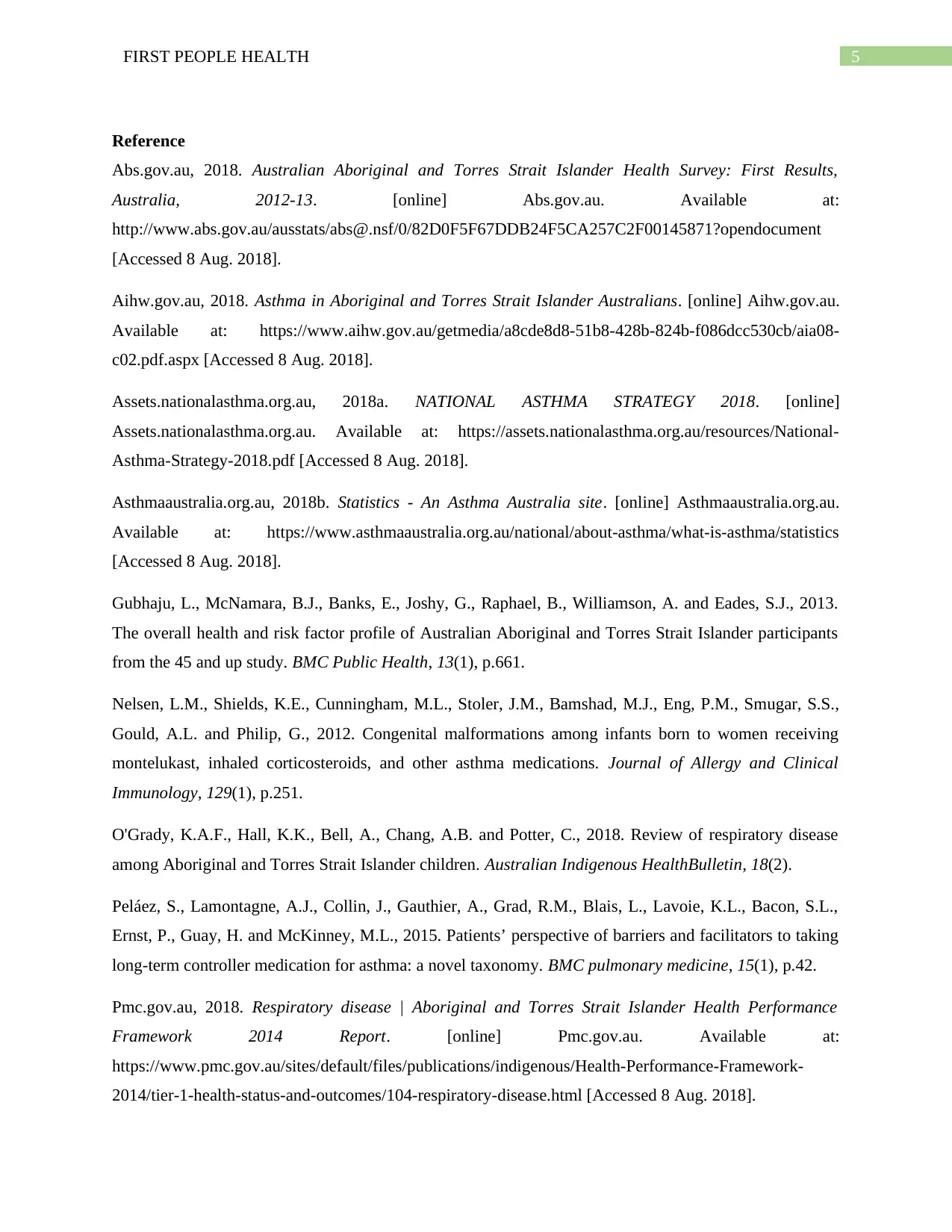
5FIRST PEOPLE HEALTH
Reference
Abs.gov.au, 2018. Australian Aboriginal and Torres Strait Islander Health Survey: First Results,
Australia, 2012-13. [online] Abs.gov.au. Available at:
http://www.abs.gov.au/ausstats/abs@.nsf/0/82D0F5F67DDB24F5CA257C2F00145871?opendocument
[Accessed 8 Aug. 2018].
Aihw.gov.au, 2018. Asthma in Aboriginal and Torres Strait Islander Australians. [online] Aihw.gov.au.
Available at: https://www.aihw.gov.au/getmedia/a8cde8d8-51b8-428b-824b-f086dcc530cb/aia08-
c02.pdf.aspx [Accessed 8 Aug. 2018].
Assets.nationalasthma.org.au, 2018a. NATIONAL ASTHMA STRATEGY 2018. [online]
Assets.nationalasthma.org.au. Available at: https://assets.nationalasthma.org.au/resources/National-
Asthma-Strategy-2018.pdf [Accessed 8 Aug. 2018].
Asthmaaustralia.org.au, 2018b. Statistics - An Asthma Australia site. [online] Asthmaaustralia.org.au.
Available at: https://www.asthmaaustralia.org.au/national/about-asthma/what-is-asthma/statistics
[Accessed 8 Aug. 2018].
Gubhaju, L., McNamara, B.J., Banks, E., Joshy, G., Raphael, B., Williamson, A. and Eades, S.J., 2013.
The overall health and risk factor profile of Australian Aboriginal and Torres Strait Islander participants
from the 45 and up study. BMC Public Health, 13(1), p.661.
Nelsen, L.M., Shields, K.E., Cunningham, M.L., Stoler, J.M., Bamshad, M.J., Eng, P.M., Smugar, S.S.,
Gould, A.L. and Philip, G., 2012. Congenital malformations among infants born to women receiving
montelukast, inhaled corticosteroids, and other asthma medications. Journal of Allergy and Clinical
Immunology, 129(1), p.251.
O'Grady, K.A.F., Hall, K.K., Bell, A., Chang, A.B. and Potter, C., 2018. Review of respiratory disease
among Aboriginal and Torres Strait Islander children. Australian Indigenous HealthBulletin, 18(2).
Peláez, S., Lamontagne, A.J., Collin, J., Gauthier, A., Grad, R.M., Blais, L., Lavoie, K.L., Bacon, S.L.,
Ernst, P., Guay, H. and McKinney, M.L., 2015. Patients’ perspective of barriers and facilitators to taking
long-term controller medication for asthma: a novel taxonomy. BMC pulmonary medicine, 15(1), p.42.
Pmc.gov.au, 2018. Respiratory disease | Aboriginal and Torres Strait Islander Health Performance
Framework 2014 Report. [online] Pmc.gov.au. Available at:
https://www.pmc.gov.au/sites/default/files/publications/indigenous/Health-Performance-Framework-
2014/tier-1-health-status-and-outcomes/104-respiratory-disease.html [Accessed 8 Aug. 2018].
Reference
Abs.gov.au, 2018. Australian Aboriginal and Torres Strait Islander Health Survey: First Results,
Australia, 2012-13. [online] Abs.gov.au. Available at:
http://www.abs.gov.au/ausstats/abs@.nsf/0/82D0F5F67DDB24F5CA257C2F00145871?opendocument
[Accessed 8 Aug. 2018].
Aihw.gov.au, 2018. Asthma in Aboriginal and Torres Strait Islander Australians. [online] Aihw.gov.au.
Available at: https://www.aihw.gov.au/getmedia/a8cde8d8-51b8-428b-824b-f086dcc530cb/aia08-
c02.pdf.aspx [Accessed 8 Aug. 2018].
Assets.nationalasthma.org.au, 2018a. NATIONAL ASTHMA STRATEGY 2018. [online]
Assets.nationalasthma.org.au. Available at: https://assets.nationalasthma.org.au/resources/National-
Asthma-Strategy-2018.pdf [Accessed 8 Aug. 2018].
Asthmaaustralia.org.au, 2018b. Statistics - An Asthma Australia site. [online] Asthmaaustralia.org.au.
Available at: https://www.asthmaaustralia.org.au/national/about-asthma/what-is-asthma/statistics
[Accessed 8 Aug. 2018].
Gubhaju, L., McNamara, B.J., Banks, E., Joshy, G., Raphael, B., Williamson, A. and Eades, S.J., 2013.
The overall health and risk factor profile of Australian Aboriginal and Torres Strait Islander participants
from the 45 and up study. BMC Public Health, 13(1), p.661.
Nelsen, L.M., Shields, K.E., Cunningham, M.L., Stoler, J.M., Bamshad, M.J., Eng, P.M., Smugar, S.S.,
Gould, A.L. and Philip, G., 2012. Congenital malformations among infants born to women receiving
montelukast, inhaled corticosteroids, and other asthma medications. Journal of Allergy and Clinical
Immunology, 129(1), p.251.
O'Grady, K.A.F., Hall, K.K., Bell, A., Chang, A.B. and Potter, C., 2018. Review of respiratory disease
among Aboriginal and Torres Strait Islander children. Australian Indigenous HealthBulletin, 18(2).
Peláez, S., Lamontagne, A.J., Collin, J., Gauthier, A., Grad, R.M., Blais, L., Lavoie, K.L., Bacon, S.L.,
Ernst, P., Guay, H. and McKinney, M.L., 2015. Patients’ perspective of barriers and facilitators to taking
long-term controller medication for asthma: a novel taxonomy. BMC pulmonary medicine, 15(1), p.42.
Pmc.gov.au, 2018. Respiratory disease | Aboriginal and Torres Strait Islander Health Performance
Framework 2014 Report. [online] Pmc.gov.au. Available at:
https://www.pmc.gov.au/sites/default/files/publications/indigenous/Health-Performance-Framework-
2014/tier-1-health-status-and-outcomes/104-respiratory-disease.html [Accessed 8 Aug. 2018].
⊘ This is a preview!⊘
Do you want full access?
Subscribe today to unlock all pages.

Trusted by 1+ million students worldwide
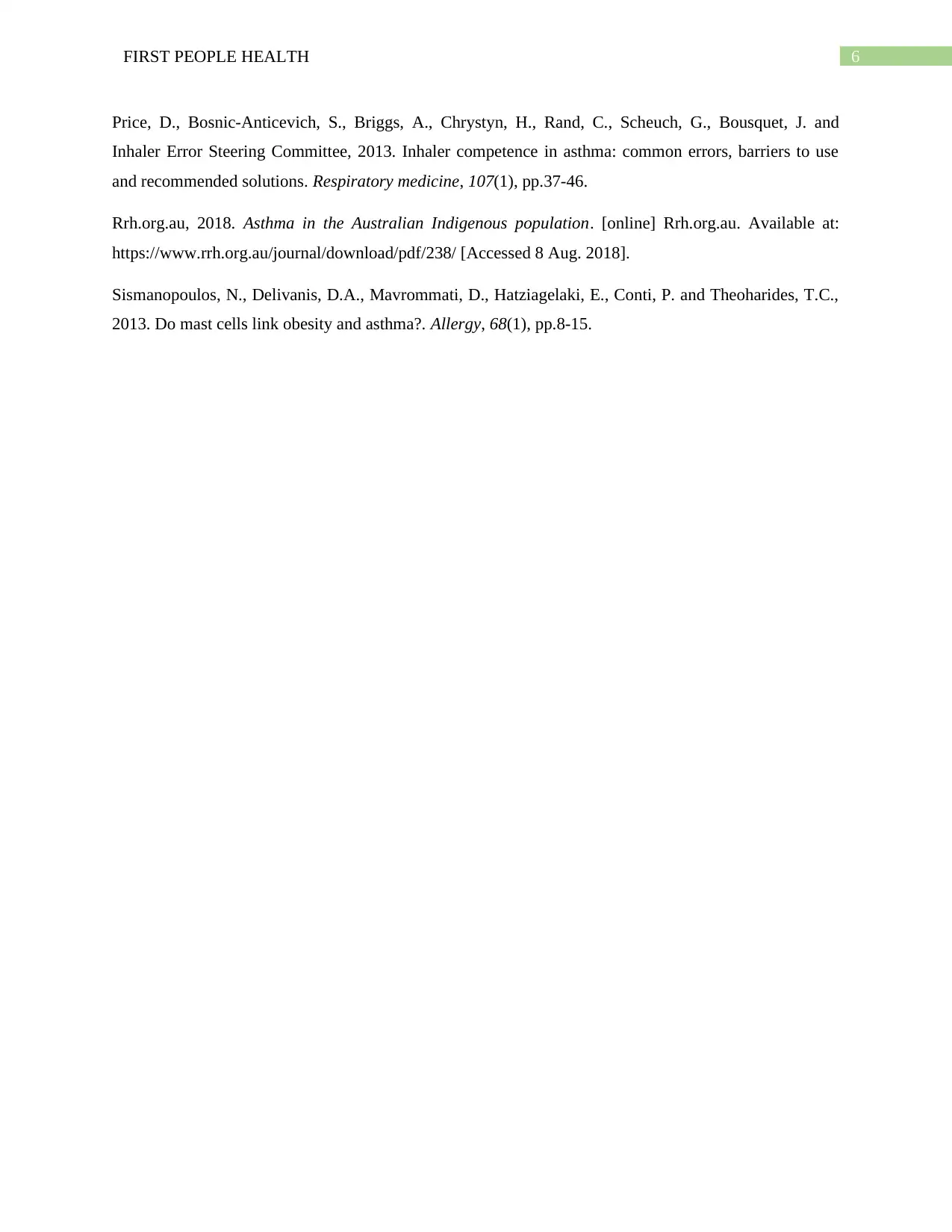
6FIRST PEOPLE HEALTH
Price, D., Bosnic-Anticevich, S., Briggs, A., Chrystyn, H., Rand, C., Scheuch, G., Bousquet, J. and
Inhaler Error Steering Committee, 2013. Inhaler competence in asthma: common errors, barriers to use
and recommended solutions. Respiratory medicine, 107(1), pp.37-46.
Rrh.org.au, 2018. Asthma in the Australian Indigenous population. [online] Rrh.org.au. Available at:
https://www.rrh.org.au/journal/download/pdf/238/ [Accessed 8 Aug. 2018].
Sismanopoulos, N., Delivanis, D.A., Mavrommati, D., Hatziagelaki, E., Conti, P. and Theoharides, T.C.,
2013. Do mast cells link obesity and asthma?. Allergy, 68(1), pp.8-15.
Price, D., Bosnic-Anticevich, S., Briggs, A., Chrystyn, H., Rand, C., Scheuch, G., Bousquet, J. and
Inhaler Error Steering Committee, 2013. Inhaler competence in asthma: common errors, barriers to use
and recommended solutions. Respiratory medicine, 107(1), pp.37-46.
Rrh.org.au, 2018. Asthma in the Australian Indigenous population. [online] Rrh.org.au. Available at:
https://www.rrh.org.au/journal/download/pdf/238/ [Accessed 8 Aug. 2018].
Sismanopoulos, N., Delivanis, D.A., Mavrommati, D., Hatziagelaki, E., Conti, P. and Theoharides, T.C.,
2013. Do mast cells link obesity and asthma?. Allergy, 68(1), pp.8-15.
1 out of 7
Related Documents
Your All-in-One AI-Powered Toolkit for Academic Success.
+13062052269
info@desklib.com
Available 24*7 on WhatsApp / Email
![[object Object]](/_next/static/media/star-bottom.7253800d.svg)
Unlock your academic potential
Copyright © 2020–2025 A2Z Services. All Rights Reserved. Developed and managed by ZUCOL.




